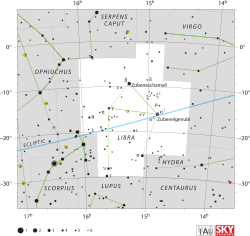Theta Librae
Appearance
| Observation data Epoch J2000 Equinox J2000 | |
|---|---|
| Constellation | Libra |
| Right ascension | 15h 53m 49.5381s[1] |
| Declination | –16° 43′ 45.457″[1] |
| Apparent magnitude (V) | 4.136 |
| Characteristics | |
| Spectral type | K0 III[2] |
| U−B color index | +0.82[3] |
| B−V color index | +1.01[3] |
| Astrometry | |
| Radial velocity (Rv) | 3.4[4] km/s |
| Proper motion (μ) | RA: +100.12[1] mas/yr Dec.: +135.27[1] mas/yr |
| Parallax (π) | 20.02 ± 0.88 mas[1] |
| Distance | 163 ± 7 ly (50 ± 2 pc) |
| Details | |
| Mass | 1.84[5] M☉ |
| Luminosity | 35[6] L☉ |
| Surface gravity (log g) | 2.99[7] cgs |
| Temperature | 4,700[7] K |
| Metallicity [Fe/H] | –0.08[7] dex |
| Rotational velocity (v sin i) | 10[8] km/s |
| Other designations | |
Theta Librae is a giant star in the southern zodiac constellation of Libra. It is located about 163 light-years (50 parsecs) from the Earth and has an estimated mass about 84% greater than the Sun. This star is radiating about 35[6] times the luminosity of the Sun from its outer atmosphere at an effective temperature of about 4,700 K.[7]
References
- ^ a b c d e Perryman, M. A. C.; et al. (April 1997). "The HIPPARCOS Catalogue". Astronomy & Astrophysics. 323: L49–L52. Bibcode:1997A&A...323L..49P.
- ^ a b "tet Lib -- Star". SIMBAD. Centre de Données astronomiques de Strasbourg. Retrieved 2011-01-24.
- ^ a b Johnson, H. L.; Iriarte, B.; Mitchell, R. I.; Wisniewskj, W. Z. (1966). "UBVRIJKL photometry of the bright stars". Communications of the Lunar and Planetary Laboratory. 4 (99). Bibcode:1966CoLPL...4...99J.
- ^ Wilson, Ralph Elmer (1953). General Catalogue of Stellar Radial Velocities. Washington: Carnegie Institution of Washington. Bibcode:1953GCRV..C......0W.
- ^ Liu, Y. J.; Zhao, G.; Shi, J. R.; Pietrzyński, G.; et al. (December 2007). "The abundances of nearby red clump giants". Monthly Notices of the Royal Astronomical Society. 382 (2): 553–566. Bibcode:2007MNRAS.382..553L. doi:10.1111/j.1365-2966.2007.11852.x.
{{cite journal}}: CS1 maint: unflagged free DOI (link) See online data. - ^ a b Mallik, Sushma V. (December 1999), "Lithium abundance and mass", Astronomy and Astrophysics, 352: 495–507, Bibcode:1999A&A...352..495M
- ^ a b c d Mallik, Sushma V. (October 1998). "Chromospheric activity in cool stars and the lithium abundance". Astronomy and Astrophysics. 338: 623–636. Bibcode:1998A&A...338..623M.
- ^ Bernacca, P. L.; Perinotto, M. (1970). "A catalogue of stellar rotational velocities". Contributi Osservatorio Astronomico di Padova in Asiago. 239 (1). Bibcode:1970CoAsi.239....1B.

